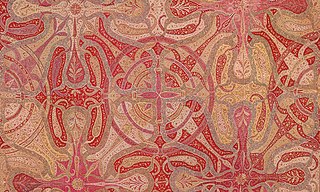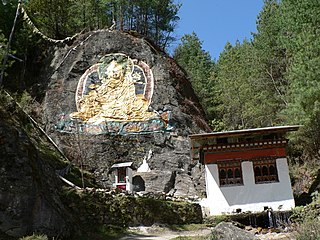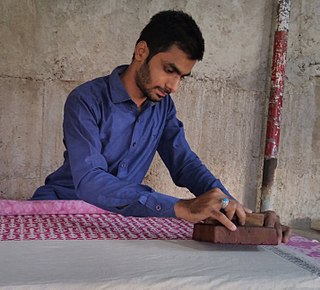
A handicraft, sometimes more precisely expressed as artisanal handicraft or handmade, is any of a wide variety of types of work where useful and decorative objects are made completely by one’s hand or by using only simple, non-automated related tools like scissors, carving implements, or hooks. It is a traditional main sector of craft making and applies to a wide range of creative and design activities that are related to making things with one's hands and skill, including work with textiles, moldable and rigid materials, paper, plant fibers,clay etc. One of the oldest handicraft is Dhokra; this is a sort of metal casting that has been used in India for over 4,000 years and is still used. In Iranian Baluchistan, women still make red ware hand-made pottery with dotted ornaments, much similar to the 5000-year-old pottery tradition of Kalpurgan, an archaeological site near the village. Usually, the term is applied to traditional techniques of creating items that are both practical and aesthetic. Handicraft industries are those that produce things with hands to meet the needs of the people in their locality without using machines.

A craft or trade is a pastime or an occupation that requires particular skills and knowledge of skilled work. In a historical sense, particularly the Middle Ages and earlier, the term is usually applied to people occupied in small scale production of goods, or their maintenance, for example by tinkers. The traditional term craftsman is nowadays often replaced by artisan and by craftsperson (craftspeople).

Cashmere wool, usually simply known as cashmere, is a fiber obtained from cashmere goats, pashmina goats, and some other breeds of goat. It has been used to make yarn, textiles and clothing for hundreds of years. Cashmere is closely associated with the Kashmir shawl, the word "cashmere" deriving from an anglicisation of Kashmir, when the Kashmir shawl reached Europe in the 19th century. Both the soft undercoat and the guard hairs may be used; the softer hair is reserved for textiles, while the coarse guard hair is used for brushes and other non-apparel purposes.

Pashmina refers to a fine variant of spun cashmere, the animal-hair fibre forming the downy undercoat of the Changthangi goat. The word pashm means "wool" in Persian, but in Kashmir, pashm referred to the raw unspun wool of domesticated Changthangi goats. In common parlance today, pashmina may refer either to the material or to the variant of the Kashmir shawl that is made from it. Both generic cashmere and pashmina come from the same goat, but generic cashmere ranges from 12 to 21 microns in diameter, whereas pashmina refers only to those fibres that range from 12 to 16 microns.
The International Art and Craft Fair, Ouagadougou – better known by its French name, SIAO – is a trade show for art and handicrafts held biennially in Ouagadougou, the capital of Burkina Faso. It is one of Africa's most important arts and crafts trade shows.
Among arts and crafts that come out of Himachal Pradesh state in India are carpets, leather works, shawls, metalware, woodwork and paintings. Pashmina shawl is the product which is highly in demand not only in Himachal but all over the country. Colourful Himachali caps are also famous art work of the people. One tribe, Dom, is expert in manufacturing bamboo items like boxes, sofas, chairs, baskets and racks. Metalware of the state include utensils, ritualistic vessels, idols, gold and silver jewelleries.
The indie design movement is made up of independent designers, artists, and craftspeople who design and make a wide array of products − without being part of large, industrialised businesses. The indie design movement can be seen as being an aspect of the general indie movement and DIY culture.
Colombian handicraft history can be traced back to the Stone Age to the lithic instruments in El Abra stadial. Some of the first pottery samples known in Colombia were found in the Neolithic 3 — Pottery Neolithic (PN) Zipacón settlements. The earliest examples of goldwork have been attributed to the Tumaco people of the Pacific coast and date to around 325 BCE. Gold would play a pivotal role in luring the Spanish to the area now called Colombia during the 16th century.

Bhutanese art is similar to Tibetan art. Both are based upon Vajrayana Buddhism and its pantheon of teachers and divine beings.

Newar art is the art form practiced over centuries by Newar people. The pictorial art consists of:

The textiles of Mexico have a long history. The making of fibers, cloth and other textile goods has existed in the country since at least 1400 BCE. Fibers used during the pre-Hispanic period included those from the yucca, palm and maguey plants as well as the use of cotton in the hot lowlands of the south. After the Spanish conquest of the Aztec Empire, the Spanish introduced new fibers such as silk and wool as well as the European foot treadle loom. Clothing styles also changed radically. Fabric was produced exclusively in workshops or in the home until the era of Porfirio Díaz, when the mechanization of weaving was introduced, mostly by the French. Today, fabric, clothes and other textiles are both made by craftsmen and in factories. Handcrafted goods include pre-Hispanic clothing such as huipils and sarapes, which are often embroidered. Clothing, rugs and more are made with natural and naturally dyed fibers. Most handcrafts are produced by indigenous people, whose communities are concentrated in the center and south of the country in states such as Mexico State, Oaxaca and Chiapas. The textile industry remains important to the economy of Mexico although it has suffered setback due to competition by cheaper goods produced in countries such as China, India and Vietnam.

Lokta paper is a wildcrafted, handmade artisan paper indigenous to Nepal.

The crafts of India are diverse, rich in history, culture and religion. The craft of each state in India reflect the influence of different empires. Throughout centuries, crafts have been embedded as a culture and tradition within rural communities.

Lhasa Newar refers to the expatriate Newar traders and artisans who traveled between the Kathmandu Valley and Tibet from centuries ago. These Nepalese merchants conducted trade between Nepal, Tibet and Bengal, India over the Silk Road, and acted as a bridge for economic and cultural exchanges between South Asia and Central Asia.

Hebron Glass refers to glass produced in Hebron as part of a flourishing art industry established in the city during Roman rule in Palestine. The Old City of Hebron still contains a quarter named the "Glass-Blower Quarter" and Hebron glass continues to serve as a tourist attraction for the city.

Oaxaca handcrafts and folk art is one of Mexico's important regional traditions of its kind, distinguished by both its overall quality and variety. Producing goods for trade has been an important economic activity in the state, especially in the Central Valleys region since the pre-Hispanic era which the area laid on the trade route between central Mexico and Central America. In the colonial period, the Spanish introduced new raw materials, new techniques and products but the rise of industrially produced products lowered the demand for most handcrafts by the early 20th century. The introduction of highways in the middle part of the century brought tourism to the region and with it a new market for traditional handcrafts. Today, the state boasts the largest number of working artisans in Mexico, producing a wide range of products that continue to grow and evolve to meet changing tastes in the market.
The Surat Zari Craft is a textile product of Surat district in Gujarat, India, which is made from yarns of silk and cotton mixed with gold, silver or copper. The zari threads are used to make intricate designs by weaving into generally silk fabrics. Its use is extensive in textile industries and handicrafts. The Surat Zari is either woven on cloth or hand embroidered to form fabric borders or used as part on the body of the cloth. The zaris are used in fabrics made in Varanasi and a few other places in Uttar Pradesh, Tamil Nadu, Karnataka and Andhra Pradesh. Banarasi saris made in Varanasi and Kanjivaram Saris of South India use Surat Zari extensively.

Kashmiri handicrafts is a traditional art of Kashmiri people and artisans who make, craft, and decorate objects by hand. Srinagar, Ganderbal, and Budgam are the main districts in central Kashmir which have been making handicrafts products since ages. The rest of its districts, including Srinagar, Ganderbal, and Budgam are best known for its cultural heritage which extends handicraft industry in Jammu and Kashmir, India.
The process of de-industrialisation is an economic change in which employment in the manufacturing sector declines due to various economic or political reasons. The decline in employment in manufacturing is also followed by the fall in the share of manufacturing value added in GDP. The process of de-industrialisation can be due to development and growth in the economy and it can also occur due to political factors. In other words, the term de-industrialisation means a general reduction in the industrial capacity and came into prevalence in India with the decline and collapse of the handicrafts industry by external competition from British-manufactured products during the 19th century.

Pakistani craft has a long tradition and history. It is a traditional work or art of Pakistani people to produce, design or shape objects by using simple tools or simply by hand. It is generally produced by an individual, group or independent artists, and while it is an ancient custom, artists process traditional craft material such as brass, wood, clay, textiles, paper, or other embroidery material to create handmade items. Stone carving, sandstone, onyx, metalwork, pottery, and ajraks are commonly used techniques and materials to work upon handicrafts.















